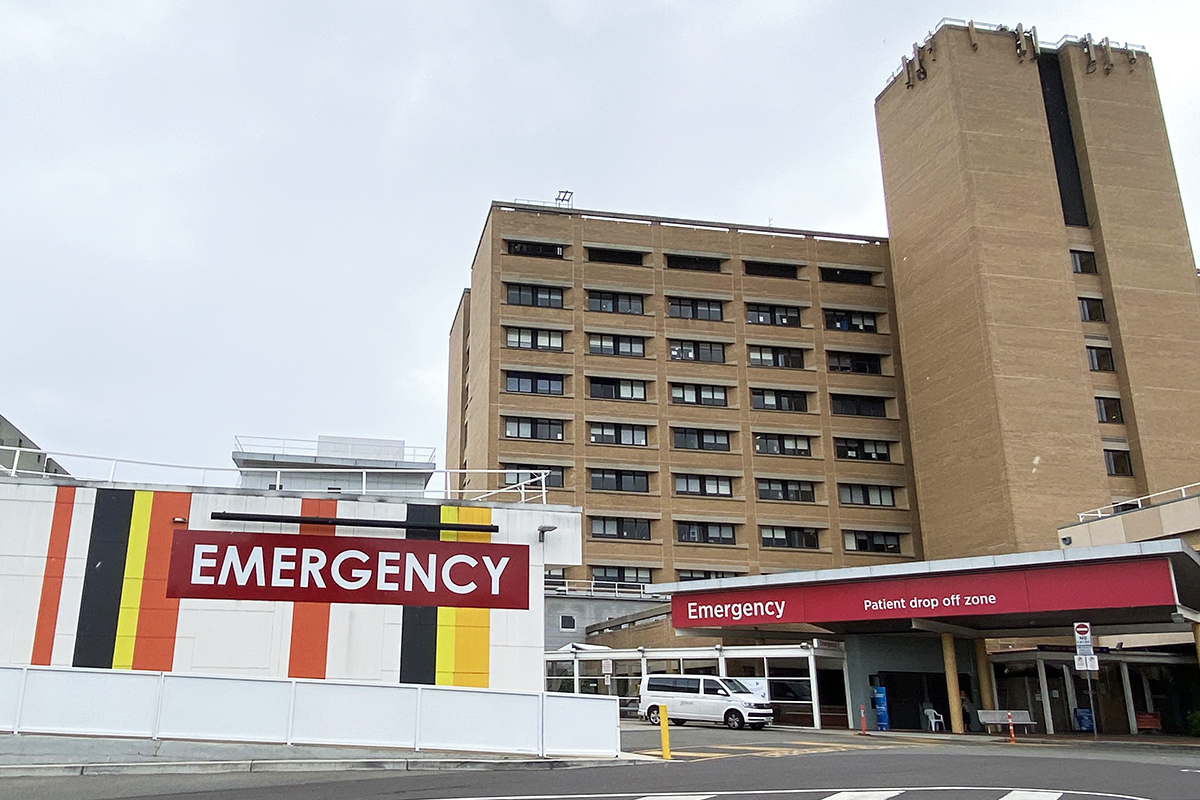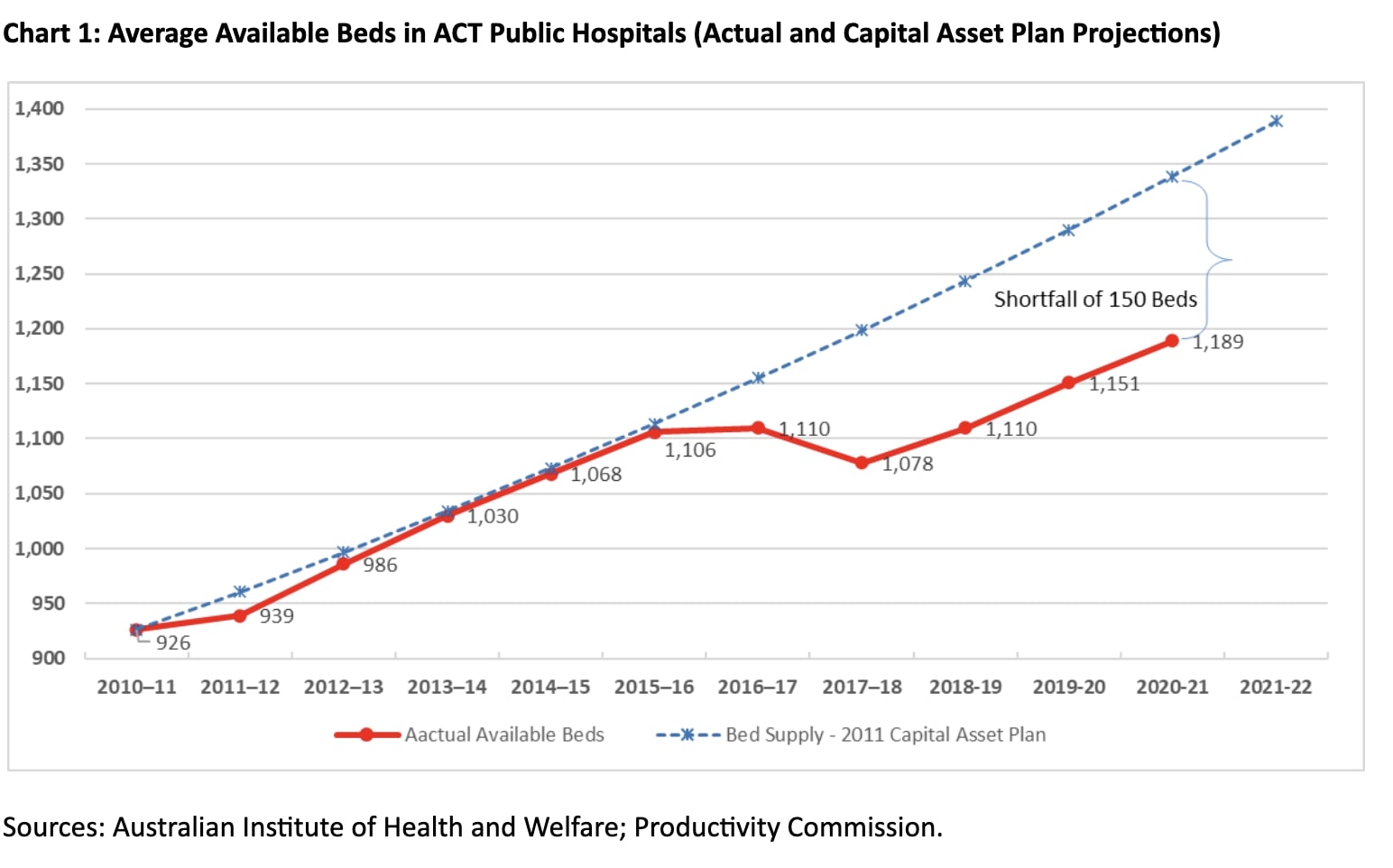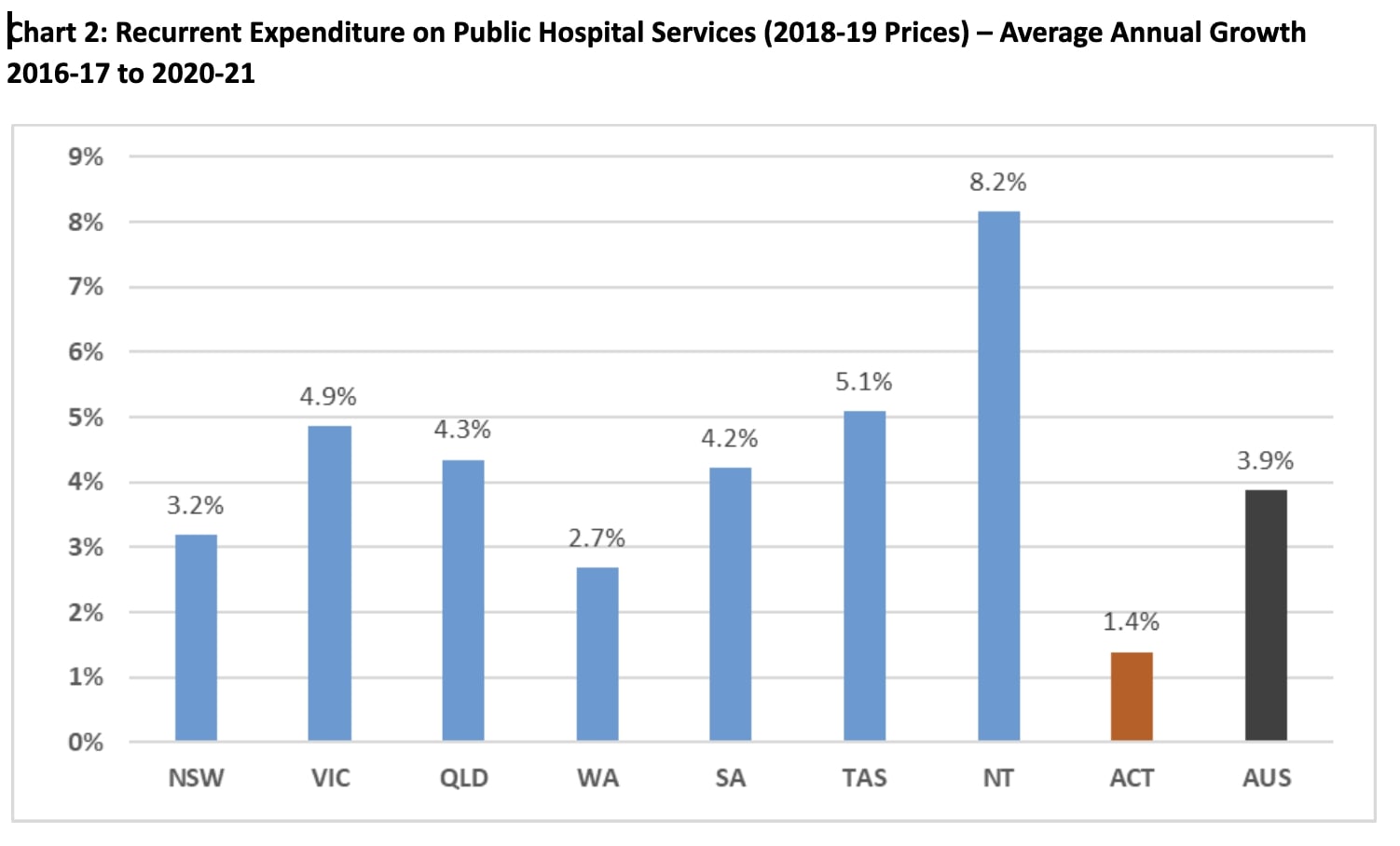
Here it is, laid bare, the funding disgrace that reveals the depth of the ACT government’s financial neglect that’s led to today’s deadly crisis in the hospital system. JON STANHOPE & KHALID AHMED trace what happened when Andrew Barr and Shane Rattenbury scaled back hospital spending in 2015 – and the years the ACT was the only jurisdiction in Australia to cut health expenditure.
THE recent unutterably sad deaths of two children presenting at the emergency department of the Canberra Hospital has again brought the state of our public health system into focus.
We have on several occasions in recent years written about what we have described as a “crisis” in health care in Canberra.
We have ascribed the central cause of that “crisis” to ongoing and persistent cuts, in real terms, to health funding and an associated shift in funding policy for health care.
By way of example, between 2015-16 and 2018-19, presentations at emergency departments in Canberra, that resulted in admission to hospital, increased at an average rate of 2.5 per cent a year, while expenditure was cut at a compounding rate of 2.5 per cent annually. Nationally, such presentations grew at 3.5 per cent a year while expenditure increased by 4.8 per cent annually. The ACT was the only jurisdiction in Australia to cut expenditure.
However, the funding constraint has not been limited to emergency departments. Over the last decade, there has been a significant change in the ACT government’s priorities and an associated shift in funding policy for health care. The changes are clearly demonstrated, for example, by a review of bed numbers in our public hospitals (Chart 1).
The change in funding policy coincided with the retirement in late 2014 of the then Chief Minister and Minister for Health, Katy Gallagher, before her move to the Senate.
Gallagher had, consistent with a decision of cabinet in 2011 to adopt and fully implement a Capital Asset Plan that involved an investment of $2.8 billion in the ACT’s health infrastructure, including $1.3 billion in the redevelopment of the Canberra Hospital campus, faithfully pursued the implementation of the plan.
It is notable that until 2015 public hospital bed supply increased in line with demand projections and actual hospital separations. In a similar vein, recurrent expenditure on health increased in real terms at a rate greater than population growth. In other words, the funding policy during that period (taking inflation into account) provided for population growth as well as increasing demand.

However, from 2015 onwards, under the leadership of Andrew Barr and Shane Rattenbury, the hospital redevelopment was scaled back to less than half of the original plan, and then deferred with bed supply remaining essentially unchanged over a three-year period. Stunningly, the number of beds decreased in 2017-18 despite continued population growth and the demand for services increasing at a rate greater than population growth.
Table 1 details population growth and demand as measured by hospital separations over the two respective periods, ie before and after the decision was taken to abandon the Capital Asset Development Plan.
 Remarkably, the Productivity Commission reports that real recurrent expenditure on public hospitals in the ACT decreased at a rate of 1.6 per cent a year over the period 2015-16 to 2018-19.
Remarkably, the Productivity Commission reports that real recurrent expenditure on public hospitals in the ACT decreased at a rate of 1.6 per cent a year over the period 2015-16 to 2018-19.
We have previously noted that if the ACT government had simply maintained per-person health expenditure at the 2015-16 level, in real terms, that public hospital services in the ACT would have received about $175 million more funding in 2018-19 than was the case.
In similar vein if health expenditure in the ACT had grown at the same rate as the national average, the additional funding, in that year, would have been in the order of $238 million.
While the increase in funding for health in 2019-20 and the following year has taken the increase in health expenditure into positive territory it nevertheless remains scandalously lower than all other Australian jurisdictions (Chart 2).

Source: Australian Institute of Health and Welfare.
Over the four-year period that the growth in health expenditure averaged 1.4 per cent in real terms, the population grew, according to the ABS, by 2.4 per cent a year. In other words, health funding per person, in the ACT, is currently lower than it was seven years ago.
The impacts of the persistent funding cuts have been severe. Emergency department performance in treating patients on time, once better than the national average, is now the worst in Australia.
Similarly, overall waiting times for elective surgery are also among the worst in the nation. It goes without saying that low and moderate-income households, especially those without private health insurance, have been disproportionately affected by the underfunding of health care.
The most regressive aspect of the health policy adopted by the government is the disparity between access and treatment times for Aboriginal peoples and non-indigenous Canberrans. In 2020-21, the 90th percentile wait time for elective surgery for an indigenous person was 52 days more than for a non-indigenous person.
At one level, it is remarkable that the ACT’s hospital system has continued to operate as well as it has and we each owe thanks to the dedication, perseverance and professionalism of its staff for that, all the while acknowledging the unacceptable cost they have been asked to pay.
Regrettably, the 2022-23 Budget signals the government is intent on maintaining the status quo.

It is important to note that Budget estimates are nominal and not expressed in real terms, ie not adjusted for inflation.
The economic parameters underpinning the 2022-23 Budget, as detailed on page 8, reveal that the Wage Price Index over the estimates period will remain above 3 per cent and the Consumer Price Index, while decreasing from 3.75 per cent in 2022-23 remains above 2 per cent across the out years.
By adjusting the Budget estimates for increases in wage costs of staff, and consumer prices for non-salary expenditure, the latest ACT Budget reflects a cut in health expenditure in real terms, before any consideration is given to an increase in population or of per-person demand for health services.
We note, in particular, the almost flat expenditure profile in nominal terms (annual growth of 0.4 per cent) for community mental health services. We would have thought, in light of the regular highlighting by clinicians, service providers and the families of loved ones with mental-health issues, of the paucity of services and care options for the mentally ill that this level of funding is indefensible.
During the hearings of the Select Committee on Estimates, when asked by the Opposition Leader Elizabeth Lee about the low expenditure growth factored into the Budget, the Treasurer Andrew Barr explained that the 2021-22 Budget base was inflated due to one-off covid-related expenditures, and that the actual growth (presumably when such temporary expenditures are removed from the base) was higher.
While Ms Lee’s question related to total Budget expenditure, it nevertheless begs an important question, most pertinently in respect of the health budget. Namely, can the Treasurer advise what expenditures in the 2021-22 allocation for health care were temporary and have they been discontinued?
Jon Stanhope is a former chief minister of the ACT and Dr Khalid Ahmed a former senior ACT Treasury official.
Who can be trusted?
In a world of spin and confusion, there’s never been a more important time to support independent journalism in Canberra.
If you trust our work online and want to enforce the power of independent voices, I invite you to make a small contribution.
Every dollar of support is invested back into our journalism to help keep citynews.com.au strong and free.
Thank you,
Ian Meikle, editor




![For graphic designer Tracy Hall, street art is like any artwork, her canvas has been swapped out for fences and plywood, her medium changing from watercolours to spray paint.
A Canberra resident for 13 years, Tracy has been a street and mural artist for the past five.
Her first exploration into grand-scale painting was at the Point Hut toilets in Banks five years ago. “They had just finished doing up the playground area for all the little kids and the words [of graffiti] that were coming up weren’t family friendly,” she says.
“So I ended up drawing this design and I got approval for the artwork.”
Many of Tracy’s time-consuming artworks are free, with thousands of her own dollars put into paint.
@traceofcolourdesigns
To read all about Tracy's fabulous street art, visit our website at citynews.com.au or tap the link in our bio! 🎨🖌
#canberranews #citynews #localstories #canberrastories #Citynews #localnews #canberra #incrediblewomen #journalism #canberracitynews #storiesthatmatter #canberralocals #artist #streetart #streetartist #StreetArtMagic](https://scontent.cdninstagram.com/v/t39.30808-6/490887207_1225841146218103_6160376948971514278_n.jpg?stp=dst-jpg_e35_tt6&_nc_cat=106&ccb=1-7&_nc_sid=18de74&_nc_ohc=MUiEmedc4VAQ7kNvwHTUMX_&_nc_oc=Adk-5HjcsfQwB-n_l8zetmr0YqMaupGjrl2gNVCZdsmkxwn-oqjBg_V7pLtGggCE43s&_nc_zt=23&_nc_ht=scontent.cdninstagram.com&edm=ANo9K5cEAAAA&_nc_gid=3fjL16DA7WDFMmGuPmhczg&oh=00_AfG9D9FLSkek_ss8Me1cdnfGfXnkGWa8LRuaBCdFrEzzug&oe=680991D4)



Leave a Reply